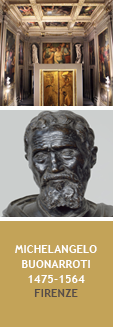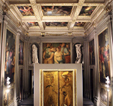(Casa Buonarroti Florence)
A museum and a monument, a place of memory and of celebration of the genius of Michelangelo and, at the same time, a sumptuous baroque display and exhibition of the rich art collections of the family, the Casa Buonarroti offers one of the most unique visitor experiences among the many museums of Florence.
First of all it offers the pleasure of seeing two famous reliefs in marble, masterpieces of the young Michelangelo: the Madonna of the Stairs, an intense witness to his passionate study of Donatello, and the Battle of the Centaurs, an eloquent testimony of unquenched love for classical art.
No less meaningful for those who enter the great doors of the seventeenth-century palace in Via Ghibellina 70 in Florence, is connecting the works of Michelangelo to the worldly affairs of the Buonarroti family. They spared no expense in enlarging and decorating their residence—a place where they preserved a precious cultural heritage (including important archives and a library) and rare collections of art: paintings, sculptures, ceramics, and archaeological objects which today are displayed on the two floors of the museum.
Michelangelo’s Drawings
On the second floor, a specially furnished room presents a rotating display of selections from the Casa’s collection of two hundred and five precious sheets by Michelangelo. Let us briefly recall their history.
In a famous passage from his biography of Michelangelo, Giorgio Vasari says that the artist, as a sign of his desire for perfection, decided, before his death in Rome in 1564, to burn “many drawings, sketches, and cartoons made with his own hand, so that no one would see the labors he endured and the ways he tried out his own genius, in order to appear nothing but perfect.”
Fortunately, when he died, many of Michelangelo’s drawings were in Florence in the hands of the family, and his nephew Leonardo recovered more of them in Rome. Around 1566 his nephew gave the Duke of Tuscany, Cosimo I dei Medici, a goodly number, in order to satisfy his collecting desires, as well as the Madonna of the Stairs and what was still left in Michelangelo’s studio in Via Mozza, which he had left thirty years earlier when he moved from Florence to Rome.
The Buonarroti family’s collection of Michelangelo’s papers was at this point the richest in the world—and still is, with its more than two hundred pieces, despite all the serious assaults it has suffered. At the end of the eighteenth century the collection was impoverished when the revolutionary Filippo Buonarroti, already exiled in Corsica, made an initial sale to French painter and collector Jean Baptiste Wicar.
In October 1858, the collection was further reduced when Cavalier Michelangelo Buonarroti sold some sheets to the British Museum. A few months earlier, Cosimo Buonarroti, last direct heir of the family, had died. He owned the largest part of Michelangelo’s papers, including the drawings. In his will he left them all to be enjoyed by the public, together with the palace in Via Ghibellina and its contents.
Beginning in 1859, the precious drawings were left exposed for long years in frames and showcases in the Casa Buonarroti, which had become a museum. It was not until 1960 that they were withdrawn from such careless custody. They were then taken to the Prints and Drawings Department of the Uffizi and restored. Only in 1975 were they returned to Casa Buonarroti. At present, the rotating display of the invaluable sheets within the museum adheres to the most current conservation principles.
The significance of Casa Buonarroti is not limited, however, to the celebration of such an extraordinary figure as Michelangelo, although it possesses and exhibits works and documents about him that are enriched by gifts added to the family patrimony or pieces consigned on deposit by Florentine museums. Among these, two famous works by Michelangelo, the Wooden Model for the Facade of San Lorenzo and the enthralling River God, a large preparatory model for a statue that was never made for the New Sacristy. There are also the two sixteenth-century Noli me tangere paintings, which are based on a lost preparatory cartoon by Michelangelo.
The idea to create a sumptuous building to glorify the family and especially its great ancestor goes back to the above mentioned Michelangelo Buonarroti the Younger, an eminent literary figure and cultural leader who, beginning in 1612 and for approximately the next thirty years, employed on the palace interior and particularly in the gallery and its three adjacent rooms the greatest artists working in Florence: from Empoli to Passignano, from Artemisia Gentileschi to Pietro da Cortona, from Giovanni da San Giovanni to Francesco Furini and the young Jacopo Vignali.
In these splendid rooms, Michelangelo the Younger placed the most valuable pieces of his collection, many of which are still part of the museum tour, among them, a wooden predella with Stories of St. Nicholas, the masterpiece of Giovanni di Francesco, a follower of Domenico Veneziano.
In the life of an institution whose principal goal is research, one cannot forget the annual schedule of exhibitions relating to the cultural, artistic, and historical heritage and memories of Casa Buonarroti that go beyond Michelangelo and his time.
For many years now, such exhibitions have gained international renown, both for the value of the loans and originality of the themes addressed and also for the sound scholarship of the catalogues that accompany them.








